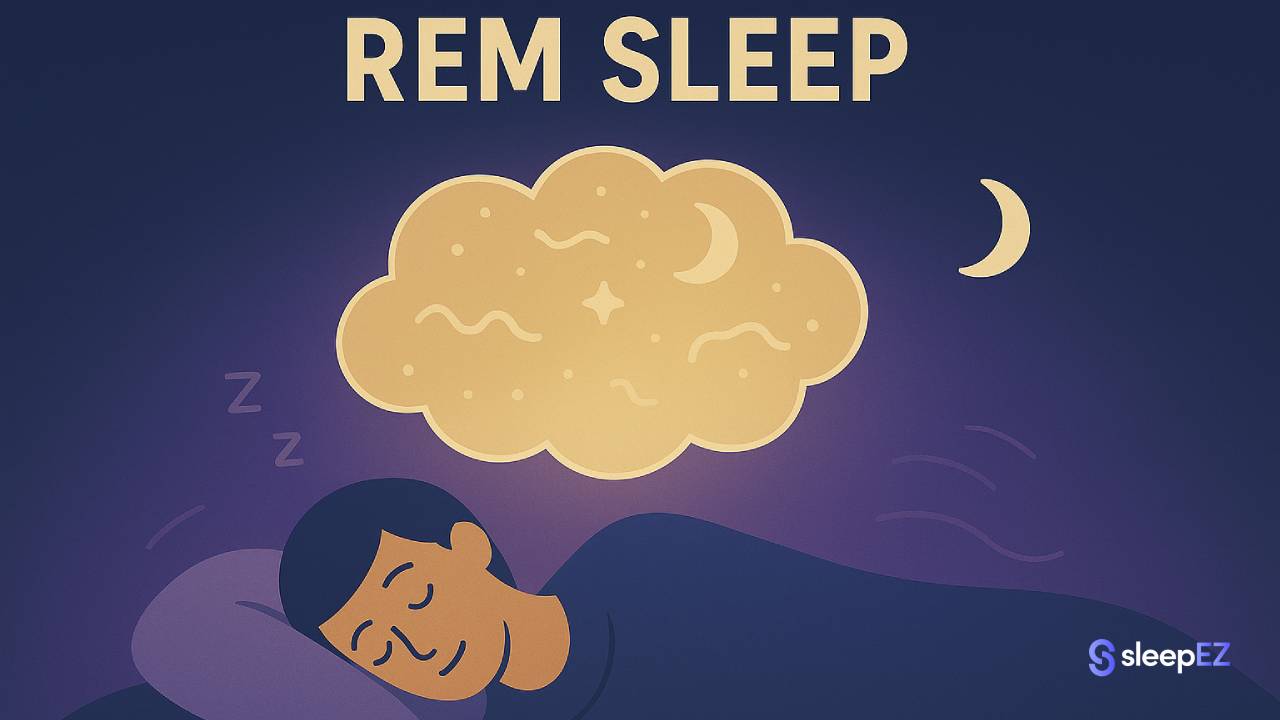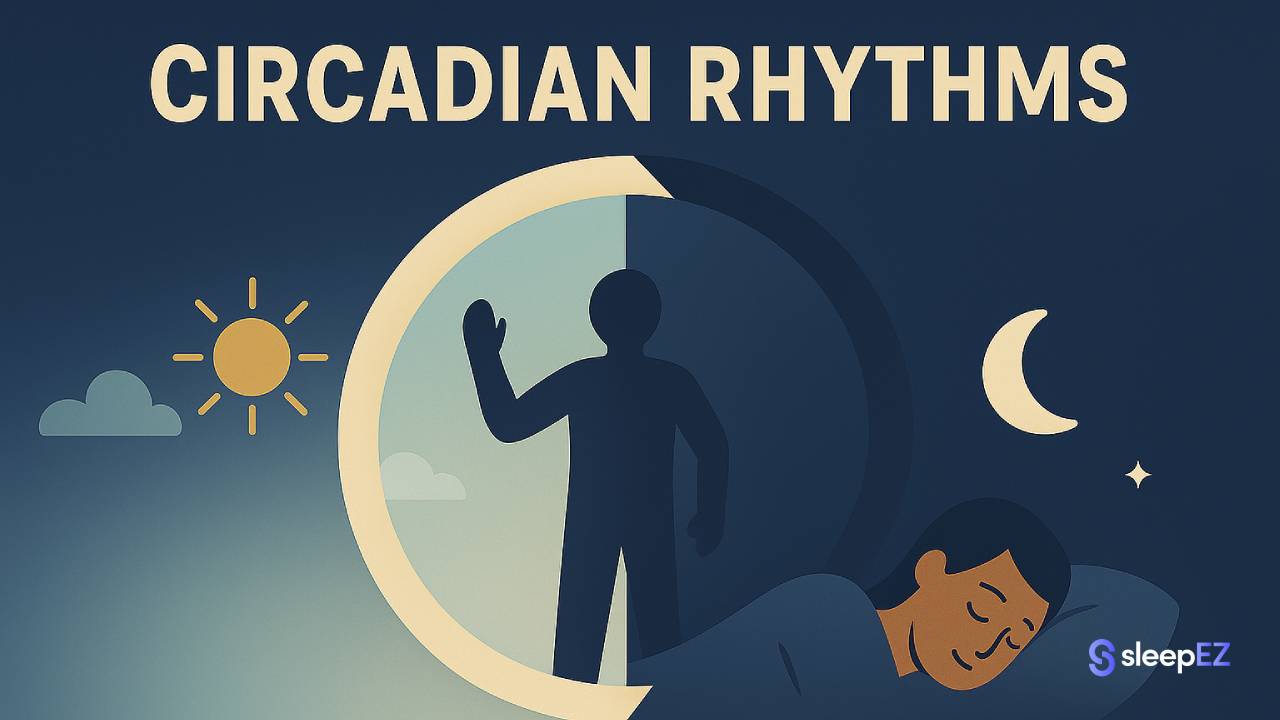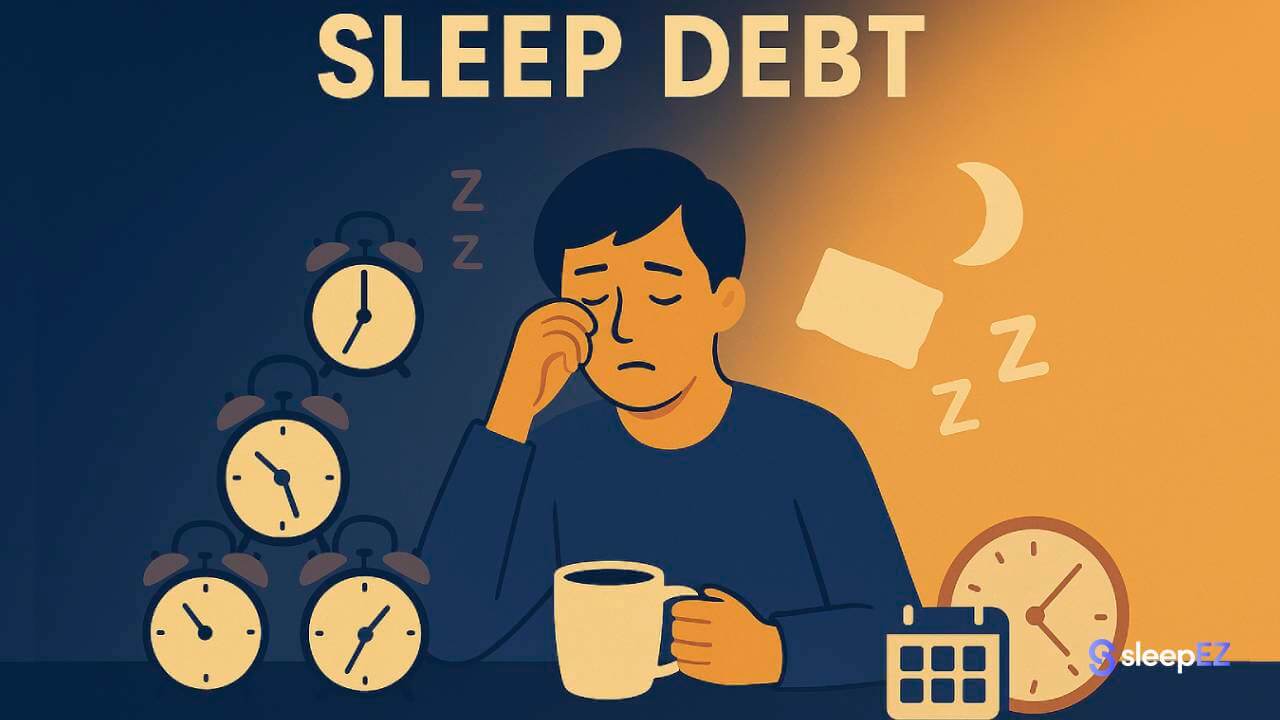Key Takeaways
- What it is: REM (Rapid Eye Movement) is a deep sleep stage where your brain is highly active, your eyes dart rapidly, and your muscles are temporarily paralyzed. This is when vivid dreams occur.
- Why it's important: REM sleep processes memories, regulates emotions, and helps you learn new skills. Without it, you experience brain fog and mood problems.
- How much you need: Adults need REM sleep to make up 20-25% of total sleep time. That's about 90-120 minutes per night if you sleep 8 hours.
- How to improve it: Stick to a consistent sleep schedule, avoid alcohol before bed, and sleep in a cool, dark, quiet room.
What Is REM Sleep?
REM sleep is the final stage of your sleep cycle. Think of it as your brain's night shift, when it sorts through the day's information and files away what matters.
REM stands for Rapid Eye Movement. During this stage, your eyes dart back and forth beneath your closed eyelids. Your brain becomes nearly as active as when you're awake. But your body does something strange: it paralyzes your voluntary muscles. This keeps you from physically acting out your dreams.
Most vivid dreams happen during REM sleep.
What Happens During REM Sleep?
Your body and brain go through distinct changes during REM sleep. While you lie still in bed, your internal systems become surprisingly active and chaotic. Here's what's actually happening:
Brain Activity: Your brainwaves look similar to waking patterns. Your brain is processing, organizing, and storing information from the day.
Eye Movements: Your eyes move rapidly in different directions. Scientists aren't entirely sure why, but these movements give this sleep stage its name.
Muscle Atonia: Your voluntary muscles become temporarily paralyzed. Only your diaphragm (for breathing) and eye muscles continue working. This paralysis is a safety feature that prevents you from acting out your dreams.
Breathing & Heart Rate: Both become irregular and can speed up or slow down unpredictably, unlike the steady patterns in other sleep stages.
The Sleep Cycle: When Does REM Sleep Occur?
Sleep doesn't happen all at once. Your brain moves through a complete sleep cycle that lasts about 90-110 minutes. This cycle repeats 4-5 times throughout the night.
Each cycle includes these stages:
- NREM Stage 1: Light sleep, the transition between wake and sleep (a few minutes)
- NREM Stage 2: Slightly deeper sleep where your body temperature drops and heart rate slows (10-25 minutes)
- NREM Stage 3: Deep sleep, also called slow-wave sleep. This is when your body repairs tissue and strengthens your immune system (20-40 minutes)
- REM Sleep: The mentally restorative stage (10-60 minutes, depending on which cycle)
The first REM period of the night is short, usually around 10 minutes. But with each cycle, REM periods get longer. Your longest and most intense REM sleep happens in the early morning hours, which is why you often wake from a vivid dream.
REM Sleep vs. Deep Sleep: What's the Difference?
People often confuse these two stages. Here's how they differ:
| Feature | Deep Sleep | REM Sleep |
|---|---|---|
| Primary Function | Physical restoration and immune support | Mental restoration and memory processing |
| Brain Activity | Slow waves (delta waves) | Active, fast waves (similar to waking) |
| Body Movement | Minimal, but possible | Paralyzed (atonia) |
| Dreams | Rare and vague if they occur | Vivid and story-like |
You need both. Deep sleep fixes your body. REM sleep fixes your mind.
Why Is REM Sleep So Important?
REM sleep does critical work for your mental health and cognitive function. While deep sleep repairs your body, REM sleep repairs your mind. It's when your brain processes the day's experiences and prepares you mentally for tomorrow.
Here's what happens when you get enough REM sleep:
Memory Consolidation: During REM sleep, your brain decides what to keep and what to discard. It strengthens important memories and weakens irrelevant ones. Without enough REM sleep, you'll struggle to remember what you learned yesterday.
Learning: When you practice a new skill, your brain refines that skill during REM sleep. Musicians, athletes, and anyone learning a complex task need REM sleep to cement their progress.
Emotional Regulation: Your brain processes difficult emotions during REM sleep. It helps you work through stressful experiences and reduces their emotional intensity. People who don't get enough REM sleep become more irritable and emotionally reactive.
Creativity: REM sleep creates new connections between unrelated ideas. Many people report solving problems or having creative breakthroughs after a good night's sleep. Your sleeping brain can see solutions your waking mind misses.
How Much REM Sleep Do You Need?
The amount varies by age, and the difference is dramatic. Babies spend most of their sleep in REM because their brains are building new neural connections at an extraordinary rate. As you age, the percentage decreases but remains essential throughout your life.
Adults: Aim for REM sleep to make up 20-25% of your total sleep time. If you sleep 8 hours, that's 90-120 minutes of REM sleep spread across the night.
Infants & Children: Babies spend up to 50% of their sleep in REM. Young children need about 30-40%. Their brains are developing rapidly, which requires much more REM sleep than adults need.
As you age, your REM sleep naturally decreases slightly. But it should still make up roughly a fifth of your sleep throughout adulthood.
What Happens if You Don't Get Enough REM Sleep?
The effects show up quickly. Even one night of poor REM sleep can leave you feeling mentally off. When REM deprivation continues for several nights, the symptoms become more pronounced and harder to ignore.
Poor memory and brain fog: You'll have trouble remembering conversations, where you put things, or what you read. Your thinking becomes slower and less sharp.
Difficulty learning: New information won't stick. Whether you're studying for an exam or learning to use new software, you'll find it frustratingly hard to retain what you're trying to learn.
Increased moodiness: You'll feel more irritable, anxious, or emotionally fragile. Small frustrations feel bigger. You might snap at people or feel overwhelmed more easily.
Potential long-term health issues: Chronic REM sleep deprivation has been linked to increased risk of obesity, diabetes, and cardiovascular disease. Some research suggests it may also increase the risk of developing dementia later in life.
How to Get More REM Sleep: An Actionable Checklist
You can't force your brain into REM sleep, but you can create the conditions that make it more likely.
Step 1: Build an Unbreakable Sleep Schedule
Go to bed and wake up at the same time every day. This means weekends too, no matter how tempting it is to sleep in.
This is the single most powerful thing you can do. Your brain relies on consistent timing to regulate your circadian rhythm. When you have a stable schedule, your sleep cycles stabilize too. Your brain knows when to expect sleep and moves through the stages more efficiently, including spending more time in REM.
Set a specific bedtime. Set a specific wake time. Protect them.
Step 2: Avoid REM-Suppressing Substances
Alcohol is the biggest REM killer. It might seem like a relaxing nightcap helps you sleep, but it's actually sabotaging the most mentally restorative part of your night.
Many people drink alcohol to help them fall asleep. It does make you drowsy initially. But as your body metabolizes the alcohol during the night, it severely disrupts your sleep architecture. You'll spend much less time in REM sleep, particularly in the second half of the night when REM periods should be longest.
Avoid alcohol for at least 3-4 hours before bed. Better yet, skip it entirely on nights when you need quality sleep.
Certain medications can also suppress REM sleep, including some antidepressants and beta-blockers. If you suspect your medication is affecting your sleep, talk to your doctor. Don't stop taking prescribed medication without medical guidance.
Step 3: Master Your Sleep Environment
Your brain needs specific cues to move through sleep stages uninterrupted. The ideal environment is cool, completely dark, and silent.
Even minor disruptions from light or noise can pull you out of deep sleep or REM sleep. When this happens repeatedly, your sleep architecture fragments. You might technically sleep for 8 hours but get very little restorative sleep.
Your Toolkit for Uninterrupted Sleep:
For Total Darkness: Light is a primary wake signal to your brain. Even small amounts of light from streetlamps, electronics, or a bathroom nightlight can disrupt your sleep cycles.
A high-quality sleep mask creates complete darkness. The Dreamy Sounds Sleep Mask not only provides 100% blackout but also has built-in Bluetooth speakers. You can listen to calming sounds that help you fall asleep without uncomfortable earbuds pressing into your ears.
Read: Best Bluetooth Sleep Mask 2025
For Complete Silence: Sudden noises are notorious for disrupting sleep. A passing truck, a neighbor's dog, a car door slamming. These sounds can pull you out of deep sleep or REM sleep even if you don't fully wake up.
You have two options:
To Block Noise: Quietbuds silicone earplugs create a physical seal that blocks sound. They're perfect for stopping inconsistent, jarring noises that would otherwise interrupt your sleep.
Read: Ear Plugs For Sleeping 2025
To Mask Noise: Some people find total silence unsettling. If that's you, the Hush Sound Machine creates a consistent, soothing audio blanket. It masks sudden noises without introducing anything disruptive. Your sleep stays smooth and stable.
Keep Your Room Cool: Your body temperature needs to drop to fall asleep and stay asleep. Keep your bedroom between 15-19°C. Use breathable bedding. If you sleep hot, consider a cooling mattress pad.
Step 4: Get Morning Sunlight
Within 30 minutes of waking up, get outside for 10-15 minutes. The natural light hitting your eyes sends a powerful signal to your internal clock. This simple morning habit has a direct impact on how well you sleep that night.
Natural light exposure in the morning anchors your circadian rhythm. It tells your brain that daytime has started, which helps it know when nighttime should begin. This timing signal promotes robust, properly timed sleep cycles later that night, including longer REM periods.
If you can't get outside, sit near a window or use a light therapy box rated at 10,000 lux.
When Should You Talk to Your Doctor?
See a doctor if you experience:
-
Excessive daytime sleepiness despite getting 7-9 hours of sleep. This suggests your sleep quality is poor, possibly due to insufficient REM sleep or a sleep disorder.
-
Acting out your dreams physically. If you or your partner notice you're punching, kicking, or moving violently during sleep, you might have REM Sleep Behavior Disorder. In this condition, the normal muscle paralysis during REM sleep doesn't work properly. This is a medical condition that requires treatment.
-
Persistent insomnia that doesn't improve with better sleep habits.
-
Loud snoring with breathing pauses, which may indicate sleep apnea. This condition repeatedly disrupts your sleep cycles and prevents you from getting adequate REM sleep.
A sleep study can identify specific problems with your sleep architecture and help your doctor recommend appropriate treatment.




Leave a comment
This site is protected by hCaptcha and the hCaptcha Privacy Policy and Terms of Service apply.